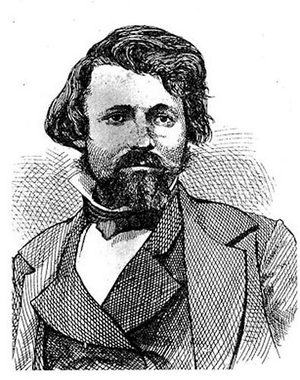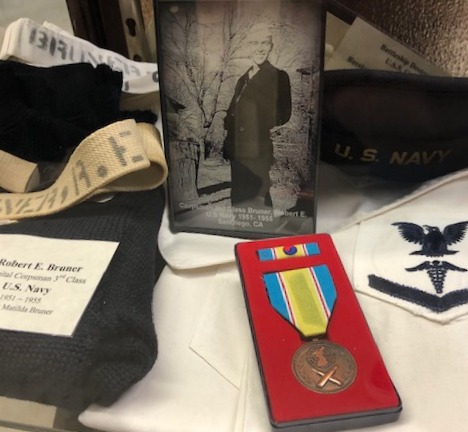What Francis Aubry lacked in height, he made up for in grit. The 5’4” French Canadian was not only extremely energetic; he also loved a challenge. Born in Quebec, Aubry moved to St. Louis, Missouri, in 1843 at the age of 18. He clerked in a store for a while, but after seeing the profits available for merchants transporting goods along the Santa Fe Trail, the adventurous Aubry started his own freighting business. His first trip down the trail was in the spring of 1846. His wagon train traveled the approximate 800 miles from Independence to Santa Fe in 45 days which was a relatively quick trip in comparison to the other wagon trains who typically took a full two to three months. Aubry returned to Independence with enough profits to fully pay off the loans he had secured to go into business.
 The young horseman concluded that speed was the key to making the most of his freighting business. In the winter of 1847-48, he made the first of his three fast and famous rides. After arriving with a wagon train in Santa Fe in October, Aubry left on horseback December 22 with five others returning to Independence. He arrived alone at his destination in a little over 14 days, 10 days less than the previous record. The following March, Aubry again accompanied a wagon train to Santa Fe. He made the return trip to Independence that time in only eight days and 10 hours. The Independence Expositor claimed that Aubry had walked 40 miles of the trip after his horse went down and slept only four and a half hours.
The young horseman concluded that speed was the key to making the most of his freighting business. In the winter of 1847-48, he made the first of his three fast and famous rides. After arriving with a wagon train in Santa Fe in October, Aubry left on horseback December 22 with five others returning to Independence. He arrived alone at his destination in a little over 14 days, 10 days less than the previous record. The following March, Aubry again accompanied a wagon train to Santa Fe. He made the return trip to Independence that time in only eight days and 10 hours. The Independence Expositor claimed that Aubry had walked 40 miles of the trip after his horse went down and slept only four and a half hours.
Aubry’s reputation for fast riding was gaining him recognition, and a $1,000 bet enticed him to carve even more time off his record. Aubry departed Santa Fe on September 12, 1948, with fresh horses having been positioned at several points along the route. When he swapped mounts for his favorite mare, Dolly, Aubry gulped down a quart of boiling coffee and was last seen riding away with a hunk of broiled buffalo meat in his hand. When he got to the place where he was to exchange Dolly for a fresh ride, there were no horses to be found, only a scalped, lifeless man. He had no choice but to continue on his favorite steed. Some reports say Dolly carried him 200 miles in 26 hours until he ran into a wagon train and got a fresh horse from the wagonmaster who promised to take Dolly back to Santa Fe. Aubry reached Independence in five days and 16 hours. On his arrival, he was helped from his horse and carried into a local hotel, his saddle soaked in blood and his thighs raw from riding. Aubry had broke down six horses on his journey. Having only slept two and a half hours and eating only six meals, the exhausted explorer strapped himself into the saddle for the last 40 hours of the trip. Aubry’s record still stands over 170 years later and garnered him nicknames such as Skimmer of the Plains and Telegraph Aubry. His freighting business, which benefited from his reputation for speed, ultimately became dubbed as the Lightning Express.
Convinced that there must be a better route for wagon trains between the Arkansas River and the Cimarron Route, Aubry set out to find a shortcut. In late 1851, he discovered a detour that became known as the Aubry Cutoff or Aubry Route. This shortcut not only saved time but was also safer and offered more water, wood and areas for grazing. Because it is thought that Aubry traveled the Bear Creek Pass on one of his quick rides, the Aubry Route has been confused with the Bear Creek Pass that connected the Upper Crossing at Chouteau’s Island to Wagon Bed Springs. In fact, area historian India Harris Simmons wrote a series of articles on the Aubry Route in the early 1900s saying as much, and a map from the History of Kearny County Volume 1 also labeled the Aubry Cutoff as the route from Chouteau’s Island to Wagon Bed Springs. That route was marked when the trail was surveyed back in the 1820s, but has been debunked as the Aubry Route.
Aubry’s Route followed the trail westward along the Arkansas River. Instead of turning south at Chouteau’s Island, it continued to a point about 12 to 15 miles above the island. The route then angled through Hamilton and Stanton Counties in Kansas and Baca County, Colorado before reaching Cold Springs in the Oklahoma Panhandle where it joined up with the Cimarron Route. According to noted trail scholar and author Leo Oliva, Aubry gave an early description of the Aubry Route to Brevet Captain S.B. Buckner, the commanding officer at Fort Atkinson. This description and a sketch map were forwarded to Fort Leavenworth. Military and stage lines used Aubry’s Route as early as 1852.
Until 1988, scholars believed that Aubry’s cut-off began at the site of Fort Aubrey, a military camp based in Hamilton County from 1865 to 1866. However, upon examining the rough terrain and sandhills in this area, Oliva and his wife came to the conclusion that the freighters would not have tried to plow through the rough sandhills south of Fort Aubrey. The route would have been used for a horse trail and nothing more; however, three miles to the east, fine sharp ruts were found for several miles south of the river which puts the wagon crossing for Aubry’s Route closer to Kendall.
The spirited and daring Aubry died in August of 1854 from a stab wound sustained in a fight with an Albuquerque newspaper publisher. Aubry took offense to a story Hanson Weightman ran about him which led to a confrontation between the two men. Aubry drew a pistol which prematurely discharged, the bullet hitting the ceiling. When Weightman saw Aubry draw his gun, he drew a bowie knife and before Aubry had time to bring his pistol down and fire a second time, Weightman stabbed him in the abdomen. The 29-year-old Aubry had made the most of his short life, securing his place in history not only for his speed and endurance but also for trailblazing the Aubry Route which continued to be used for nearly 20 years after his death.
Sources: “The Aubry Route of the Santa Fe Trail” by Leo E. Oliva, “The Santa Fe Trail Revisited” and “Maps of the Santa Fe Trail” by Gregory M. Franzwa, “The Fantastic Ride of F.X. Aubry” by David Dary, “Seattle Man Rides a Trail that leads back to 1848” by Erik Lacitis, archives of the Kansas Weekly Herald, Saturday Morning Visitor and Kansas City Star, History of Kearny County Vol. I, santafetrailresearch.com, legendsofamerica.com, The Santa Fe Trail Association and the National Park Service.











 d to the schoolhouse. There she found Miss Boyd getting ready to take up school as usual.
d to the schoolhouse. There she found Miss Boyd getting ready to take up school as usual. Kearny County Historical Society is pleased to announce that Cary and Joyce Henderson were selected as this year’s King and Queen for the annual Christmas Parade on Dec. 4. Cary is a former KCHS board member and officer, serving from 2003 until last spring.
Kearny County Historical Society is pleased to announce that Cary and Joyce Henderson were selected as this year’s King and Queen for the annual Christmas Parade on Dec. 4. Cary is a former KCHS board member and officer, serving from 2003 until last spring.
 The young horseman concluded that speed was the key to making the most of his freighting business. In the winter of 1847-48, he made the first of his three fast and famous rides. After arriving with a wagon train in Santa Fe in October, Aubry left on horseback December 22 with five others returning to Independence. He arrived alone at his destination in a little over 14 days, 10 days less than the previous record. The following March, Aubry again accompanied a wagon train to Santa Fe. He made the return trip to Independence that time in only eight days and 10 hours. The Independence Expositor claimed that Aubry had walked 40 miles of the trip after his horse went down and slept only four and a half hours.
The young horseman concluded that speed was the key to making the most of his freighting business. In the winter of 1847-48, he made the first of his three fast and famous rides. After arriving with a wagon train in Santa Fe in October, Aubry left on horseback December 22 with five others returning to Independence. He arrived alone at his destination in a little over 14 days, 10 days less than the previous record. The following March, Aubry again accompanied a wagon train to Santa Fe. He made the return trip to Independence that time in only eight days and 10 hours. The Independence Expositor claimed that Aubry had walked 40 miles of the trip after his horse went down and slept only four and a half hours. McCloskey is not new to this type of adventure. Last year he traveled the Oregon Trail. Since the first part of the SFT mirrors that of the Oregon Trail, McCloskey decided he would take up where he left off last year. After leaving Fort Scott, he joined up with the SFT at Canton. He will
McCloskey is not new to this type of adventure. Last year he traveled the Oregon Trail. Since the first part of the SFT mirrors that of the Oregon Trail, McCloskey decided he would take up where he left off last year. After leaving Fort Scott, he joined up with the SFT at Canton. He will 


